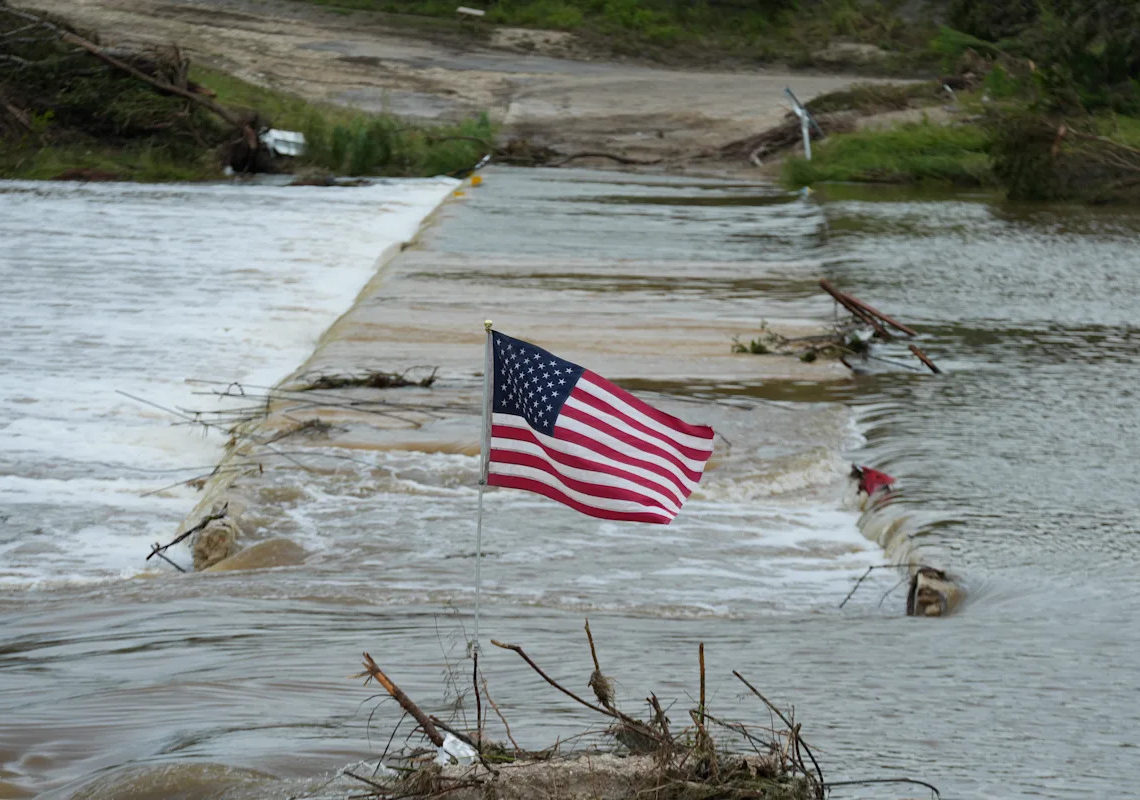Kerr County, Texas, wasn’t prepared for the deluge that killed more than 100 people this weekend, despite more than a century and a half of flash flooding along the Guadalupe River.
Other communities around the country may find themselves just as exposed for the next catastrophe, emergency managers and scientists warned — pointing to the soaring toll of climate change and the Trump administration’s steep cuts to weather and disaster spending.
Those cuts may not have played a direct role in the death toll from the central Texas floods, a point the White House argued strenuously Monday while maintaining that “the National Weather Service did its job” in predicting the rising waters. Meteorologists and climate scientists also praised NWS for its accurate, timely forecasts.
But the weather service and its parent organization are reeling from mass layoffs and early retirements pushed by President Donald Trump’s Department of Government Efficiency, and the sprawling tax bill that he signed last week canceled more than $200 million in spending that was supposed to improve weather forecasting and make communities more resilient to disasters.
Federal grants to help communities afford flood warning systems are also drying up after the Trump administration halted two main programs that once funded such work. And the White House acknowledged Monday that it’s still weighing the fate of the nation’s premier disaster responder, the Federal Emergency Management Agency, more than five months after Trump said that “I think we’re going to recommend that FEMA go away.”
Even without final answers about the cause of the Texas death toll, one longtime emergency manager said one fact is clear: “That many people did not need to die,” said Michael Coen, who served as FEMA’s chief of staff during the Biden and Obama administrations. He said Kerr County should have invested in better flood defenses or, at the very least, relocated camping cabins away from the river.
The gutting of the national infrastructure around weather emergencies comes at the same time that climate change is making severe disasters more common and more dangerous, according to studies and past warnings from the U.S. government – including during the first Trump administration.
“The frequency and the severity associated with these types of events all across the country have been substantiated over and over again,” said David Maurstad, who ran FEMA’s National Flood Insurance Program before leaving the agency last year. “I don’t know how anybody can ignore that.”
On Monday, White House press secretary Karoline Leavitt rejected attempts to connect the Texas fatalities to Trump’s policies, saying: “Many Democrat elected officials are trying to turn this into a political game, and it is not.”
The Trump administration has proposed cutting $2.2 billion from the weather service’s parent organization, the National Oceanic and Atmospheric Administration, in its fiscal 2026 budget request, affecting virtually every program at the agency. It would eliminate the Office of Oceanic and Atmospheric Research — NOAA’s main research arm, which Republicans say has been too focused on climate change — and shift much of its responsibilities to the NWS and National Ocean Service.
Many local governments’ efforts to prepare for and respond to extreme weather are already strapped by limited resources.
Kerr County — where the median household income is just under $68,000, according to U.S. Census data, and the county’s annual budget is a modest $67 million — had, in fact, considered installing a flood warning system that could have alerted campers and residents to evacuate. That was back in 2017, in the aftermath of another major flood. But officials ultimately opted against doing so, citing its cost after the county failed to win a grant to help pay for it, according to reports in The New York Times and other publications.
Kerr County’s decision to forgo an early warning system is an example of how many communities are ill-equipped to protect themselves from once-unfathomable extremes, experts said. They warned Trump administration cuts will undermine flood and other disaster preparation as climate-fueled events reset expectations for worst-imagined outcomes.
Climate scientists said hotter temperatures driven by rising greenhouse gases from burning fossil fuels likely contributed to heavy rainfall in Kerr County. A warmer atmosphere absorbs more moisture, which is later released in torrents that exacerbate floods and lead to mudslides.
Climate change likely increased total precipitation between 7 and 20 percent, said Michael Wehner, a senior scientist in the applied mathematics and computational research division at the Lawrence Berkeley National Laboratory.
Meteorological conditions were up to 7 percent wetter due to human-caused climate change, said ClimaMeter, a team of European researchers that conducts rapid analyses of extreme weather events. World Weather Attribution, a global leader in those so-called attribution studies, said the climate link was unequivocal.
“[G]iven the huge amount of scientific evidence on the link between fossil fuel-driven warming and rainfall, we don’t need to wait for an attribution study – extreme downpours like these are exactly what science expects in a rapidly warming world,” Friederike Otto, climate science professor at the Centre for Environmental Policy at Imperial College London, said in a statement.
Still, officials in Kerr County said the danger was unexpected.
“We had no reason to believe that this was gonna be any, anything like what’s happened here. None whatsoever,” Judge Rob Kelly, the county’s top elected official, told CBS News.
Maurstad said communities often resist spending on measures to protect against future disasters, instead embracing wishful thinking that the next emergency will be less severe – even as climate change has shown trends heading in the opposite direction.
“The whole mindset needs to change,” he said. “It should not be acceptable just to be able to be ready to respond and then recover the best we can.”
And the Trump administration’s culling of several key programs to help communities prepare for disasters and pay for those improvements is likely to make the situation worse.
Firings, retirements and voluntary resignations created a workforce shortage that NWS is trying to address. The Commerce Department recently exempted NWS from a department-wide hiring freeze to fill critical roles.
Leavitt said Monday that NWS “did its job.” While the San Antonio office has one vacancy, she said that NWS “offices were fully staffed” in San Angelo, Texas, and that San Antonio had 11 forecasters. She said comments blaming Trump or NWS staffing levels for the deaths “are depraved and despicable.”
Democratic Senate Minority Leader Chuck Schumer on Monday urged the Commerce Department’s inspector general to open an investigation into whether staffing shortages contributed to the loss of life in Texas.
But retired Rear Admiral Timothy Gallaudet, who served as NOAA’s acting administrator during the first Trump administration, argued in a blog post that, while short-staffing has had impacts at the service, it likely wasn’t the prime factor in the flood problems. And he said that implementing artificial intelligence – not more personnel – could strengthen preparedness by improving forecasts and automating the delivery of information to emergency managers and the public.
Such a tool, Gallaudet argued, could have delivered “the right data, a better model, and an automated emergency alerting system that may have given the citizens in Central Texas a more specific flood warning 24 hours in advance, allowing them to move to high ground when they could.”
Still, Maurstad said Trump’s decision to scrap billions of dollars of grants through FEMA’s Building Resilient Infrastructure and Communities program reversed 25 years of progress to boost poorly funded federal efforts that help communities prepare for disasters.
Trump also has denied what had up until now been routine requests for federal assistance after a disaster, said Chad Berginnis, executive director of the Association of State Floodplain Managers. Trump has not approved hazard mitigation grant program funding across several states Berginnis works with, depriving them of a key federal vehicle to finance early warning systems.
“I’m just shaking my head, because it’s like, God, the programs that we have to help in that situation are the ones that are being curtailed by the president,” he said. “It dishonors the lives lost if we don’t change behavior. At some point we have to learn lessons.”
A White House official said the Trump administration is “working with states to assist them in identifying projects and drawing down balances in a way that makes the nation more resilient.” The official said it is assessing states ability to use those dollars in light of “large unobligated balances across the board.”
The early warning system in Kerr County would have cost $1 million, Coen estimated. That’s a significant sum for a cash-strapped local government – but it pales in comparison to the $18 billion to $22 billion of total economic losses, according to AccuWeather.
That system would likely have saved lives by triggering sirens and communications for people to move out of harm’s way when NWS issued its flash flood warning at 1:14 a.m. July 4.
The problem is not limited to Kerr County, said Timon McPhearson, a lead author to the most recent United Nations Intergovernmental Panel on Climate Change assessment finalized in 2023.
McPhearson said the same type of lapses contributed to the disaster that wiped out Lahaina on Maui during the 2023 Hawaii wildfires, whose early warning system was not activated. It speaks to a broader inability for U.S. communities to cope with the ballooning risks and costs climate change poses, he said.
“You can’t estimate whether an event is going to have mass casualties or not,” said McPhearson, who is director of the Urban Systems Lab at New York University. “If this is the kind of response that’s needed — investment in early warning systems — then where’s the money going to come from?”
Less of it appears likely to come from the federal government, emergency managers said.
It’s possible some federal funds, like disaster assistance, will migrate to other departments, said Carlos Castillo, who was deputy FEMA administrator for resilience in Trump’s first administration. He said FEMA would play a role in the Texas recovery, too.
Castillo said FEMA has tried to raise awareness about early warning systems and encouraged governments to invest in them. He said many “shoulder” communities — meaning those that are not directly affected by disasters but share qualities with the ones that are — bolster their defenses after devastating events.
But he also said states cannot go it alone and that many communities do not properly budget for disasters.
“It’s impossible for a state to have the number of resources for a catastrophic event,” said Castillo, who is senior vice president of Tidal Basin Group, an emergency management consulting firm. “It’s a challenge to get the communities that haven’t been affected to put money aside.”
The post Climate change makes deadly floods more likely — but Washington is responding with cuts appeared first on Politico.



